The Motorola Moto G4 and G4 Plus Review
by Brandon Chester on August 15, 2016 8:00 AM EST- Posted in
- Smartphones
- Lenovo
- Motorola
- Moto G
- Moto G4
Display Analysis
One of the standout features of the original Moto G was its display. It was a 4.5" 1280x720 display, which gave you a higher pixel density than many other smartphones at the same price which still used 960x540 displays. It certainly wasn't the best calibrated display, but for its time it was one of the best you could find in a mid-range smartphone.
Fast forward to 2016, and we now have $200 mid-range phones shipping with 1920x1080 LCD displays. Phones have also continually gotten larger, with 5.5" seemingly being the new norm for mid-range devices. The Moto G progressed from its original 4.5" display to a 5" one with the 2014 and 2015 models, and has now gotten even larger with the 5.5" display on the Moto G4. Like competing smartphones, the Moto G4 also moves to a resolution of 1920x1080. I really feel that this continued increase in size has been at the expense of usability, but I've already mentioned that in this review, and at this point consumers don't really have any smaller alternatives at this price point anyway.
While the first three models of the Moto G maintained a 720p resolution, Motorola improved the accuracy of their displays as well as other attributes like the peak brightness and black levels. With the Moto G4 moving to a 5.5" 1080p display, I'm curious to see if there have been similar improvements to attributes beyond size and sharpness. To examine the display in greater depth than what is presented on a spec sheet, I've run our standard suite of display tests. As always, measurements are performed with an X-Rite i1Pro 2 spectrophotometer, and managed using SpectraCal's CalMAN 5 software.
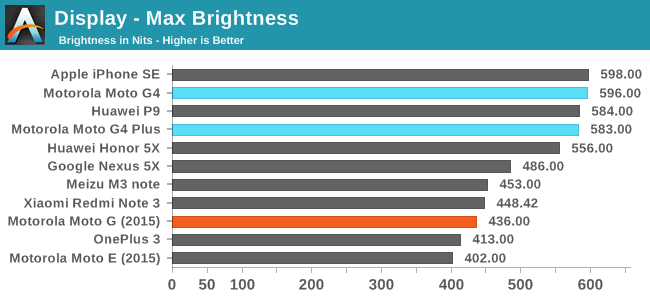
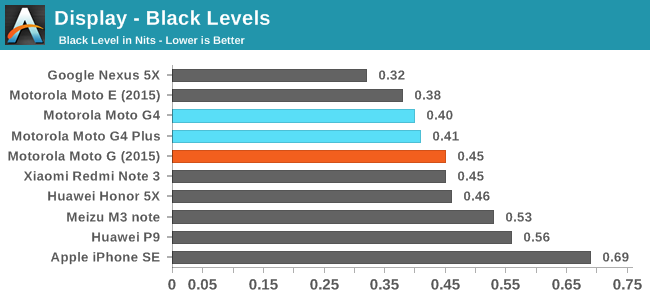
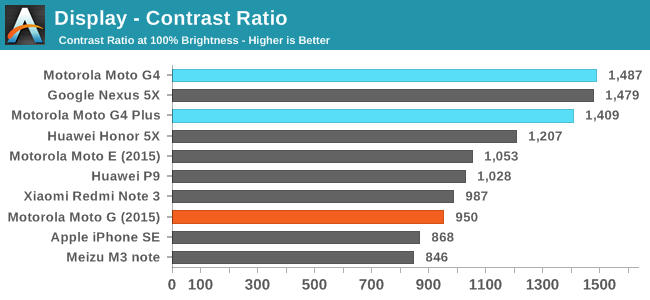
Both the Moto G4 and G4 Plus achieve a high peak brightness, as well as a relatively low black level relative to that brightness. This leads to the G4 achieving the highest contrast ratio that I've seen on a device at this price point. Among the mid-range devices that I've chosen for comparison, the Moto G4 definitely has the best display as far as brightness and contrast is concerned.
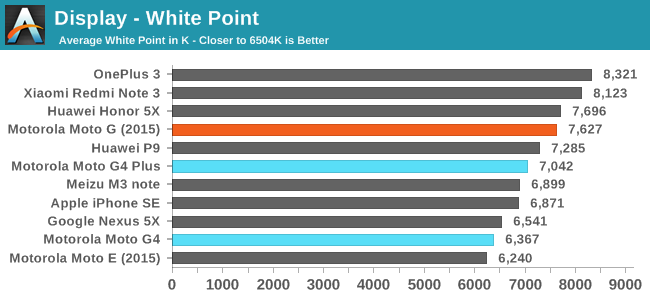
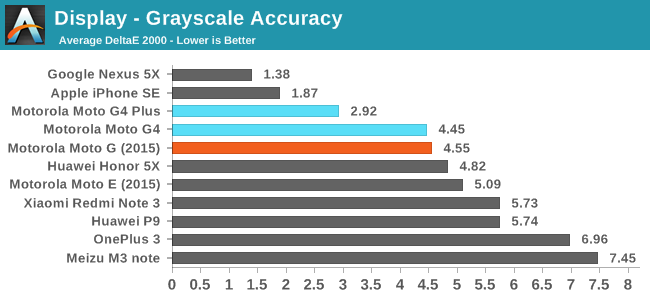
Moto G4 Plus DeltaE 2.92
Moto G4 DeltaE 4.45
Having two devices with the same LCD presents an interesting situation where the two can be compared to examine the degree of variance with the calibration. It was clear to me right after I turned on both phones that the normal Moto G4 exhibited a slight green tint and was warmer than the Moto G4 Plus, which was definitely shifted more toward blue than our target white standard of D65. In both cases gamma is a bit high, although this is more pronounced on the Moto G4 Plus. It's also clear that between these two units, the Moto G4 Plus exhibits a greater level of accuracy. For a phone that starts at $200, I would consider both results to be acceptable, but the greyscale accuracy on the G4 Plus unit is definitely a step ahead of the normal G4 unit.
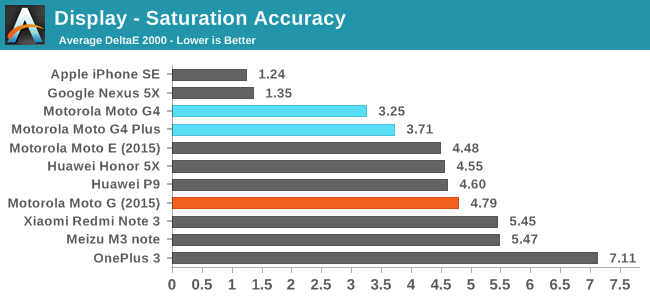
Moto G4 Plus DeltaE 3.71
Moto G4 DeltaE 3.25
The tables turn when examining saturation accuracy, as the normal Moto G4 demonstrates a slightly greater level of accuracy. The Moto G4 Plus has higher error levels with blue, cyan, and magenta due to the blue-shifted greyscale. Again, in both cases the display is more than acceptable for a $200 smartphone, but it is interesting to see what tolerances Motorola has for display variance from one unit to another.
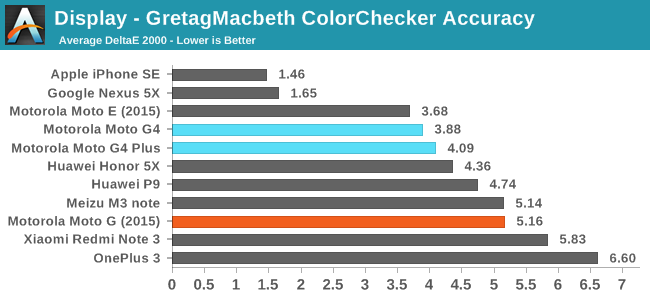
Moto G4 Plus DeltaE 4.1
Moto G4 DeltaE 3.88
Accuracy in the GretagMacbeth ColorChecker test is very similar between both Moto G4 units, but the normal G4 again has a slight advantage. This difference is mostly academic, and I would actually argue that you'd be better off with the G4 Plus because in this case the normal G4 has a critical error in the light skin shade, which is a color you're likely to come across more so than others. Ultimately both displays are very good for the price, and I don't think users are going to have any issues with the level of accuracy if it can be assumed that all Moto G4 and G4 Plus phones have similar calibration.
Drawing conclusions about displays can be a bit difficult when you have two devices to compare. On one hand, my less accurate unit could be exceptionally poor. On the other hand, my more accurate unit could be exceptionally good. I can only make concrete conclusions based on the data I've collected, and so it's probably best to evaluate based on the worst results. In this case both devices were similar enough, although the G4 Plus has the display I favor because green shifting in the greyscale is something I find much more bothersome than blue shifting, as I've gotten used to the latter due to its pervasiveness on WLED-backlit LCD displays.
The fact that both displays were relatively close in their accuracy hopefully indicates that users can expect this level of accuracy on any Moto G4 device, although I can't say that for certain. Based on the information I have, I'd say that users buying a Moto G4 should be getting a display that is exceptionally bright, with good black levels, and decent color accuracy, and I think that makes for a pretty good $200 smartphone display.


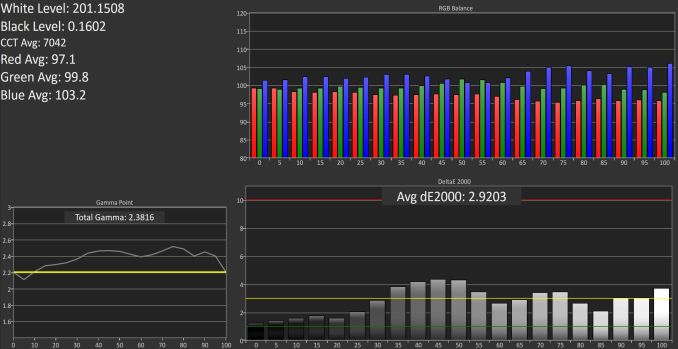

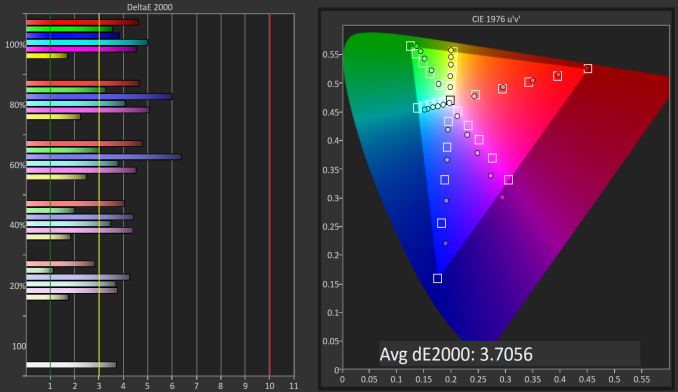

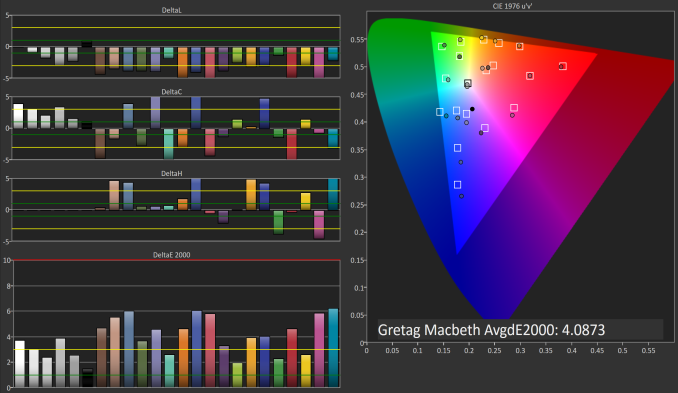
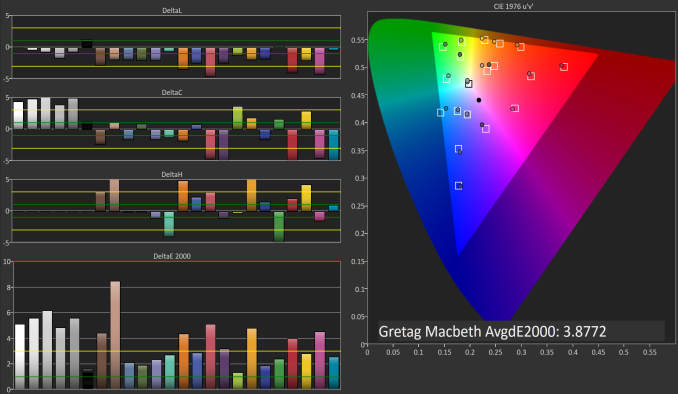








94 Comments
View All Comments
Belard - Tuesday, August 23, 2016 - link
I am disappointed with the G4, hopefully they'll correct a lot with the G5?My list:
1 - The loss of the Moto shape. The G4 looks generic, flat and "ugly" in my book. Compare to the other NON-USA Lenovo phones, I would have thought they could have done better. The curved back on the G3 and older MOTO phones gave it personality and felt good in the hand. You can tell which side is the TOP without feeling the camera hump/stripe.
2 – Its easier to pick up a phone with a curved back. Simulate it by placing your phone face-down and only picking it up by the edge.
3 – My Moto G3 is functional water proofing. Enough that I take underwater video with my phone. Was it really that hard to continue with such quality?
4 – The finger reader is completely ugly and ruins the whole phone. Should have put it on the back for the Moto Logo. That would have worked very well.
5 – 5.5”?! Can someone make a well made 5” model? The G4Play is no better than the G3… but loss its water proofing and has the plain ugly flat back.
6 – Stereo speakers. The G2 had them. The G3 has a large grill, but its not a speaker. On the G4, the mic-hole looks out of place where it is.
Come on Lenovo, fix the design for the G5 model. I’ve seen some of the Lenovo phones in Asia that are works of art. Such as the 3-layers metal phone, etc. Hell, even the new Z has some design flaws that should have been fixed.
jamesfuston - Tuesday, August 30, 2016 - link
One of the largest considerations for me in purchasing this phone was completely omitted from the summary of this article: support for every major US carrier. I get that this is a technical analysis and comparison of smartphones as computational devices, but the fact that you can use a G4/G4P on Verizon or Sprint (where a Huawei 5X will not function) is a MAJOR plus in the $200 smartphone category. Broad carrier support + fast charging, two features that provide day to day value and utility on a smartphone, make the G4 an easy pick for the best budget smartphone in my opinion.Allan_Hundeboll - Wednesday, September 7, 2016 - link
I don't own this phone but I think Brandon Chester judge this phone a little hard...Personally I used to prefer smaller phones to but once you go large you don't wont to go back. So if Brandon believe 5.5" inch is to big it's his personal preference.
I also do not agree the G4 Plus should have prioritized a faster SOC over fingerprint reader and camera. I know anandtech readers low fast hardware but for the average customer modern phones are fast enough, so better camera and the convenience offered by a fingerprint reader matters more than a slightly faster SOC.
Itbusiness.ca managed to complete PCMarks battery test with the G4 Plus and it scored a respectable 9 hours and 40 minutes.
mmartel - Tuesday, October 11, 2016 - link
I'm a long time user of a 2015 G3 who decided to buy and test out a US XT1625 G4 with 2/16 ram/storage for myself. I've also owned and gave away a Nexus 5X (loved the camera, hated the battery life). I've been using the G4 for the last 2 weeks and wanted to share a few thoughts.1. I don't doubt the official review but I think the model that was tested differs from the current firmware. I've found the 6.0.1 Android version on my device to very stable, responsive, and efficient.
2. The buttons on my device are very solid. Additionally I find the placement perfect for my hands and how I generally hold the device. YMMV obviously.
3. I don't love the size, but I am falling for the screen size. I worry about dropping the device and it's not as comfortable for me to use one handed. However that has everything to do with the size and nothing to do with the materials and shape.
5. The SoC performance really is good enough for all but the most demanding users and/or use cases. Subjectively it feels just slightly snappier than my Moto G3.
6. Real world battery life seems notably better than my G3. It seems like the device sleeps better which preserves charge when not actively using the device better.
I wasn't sure if I would keep the G4 but I'm starting to fall for the screen, longer battery life, and snappier performance compared to the G3.